Grab Taxi Innovation: Competitive Advantage and Market Analysis
VerifiedAdded on 2023/06/14
|13
|3814
|403
Report
AI Summary
This report provides an in-depth analysis of Grab Taxi's innovation strategies within the rapidly evolving taxi industry in Singapore. It highlights Grab's embrace of technology, particularly its disruptive innovation, and examines its significance to the company's competitive advantage. The study delves into factors affecting the industry, including luxury demands, innovation complexity, customer pressures, and competitor actions. It also explores the driving forces such as unstable fuel prices, client safety concerns, and changing energy regulations. Furthermore, the report employs Porter's Five Forces analysis to assess the competitive landscape, including the threat of new entrants, substitution, supplier bargaining power, buyer threats, and the degree of rivalry. The report concludes by emphasizing Grab's use of data analytics to enhance customer service and maintain its competitive edge, illustrating how machine learning and data-driven insights contribute to optimized routing and improved user experiences. This comprehensive analysis underscores the importance of innovation for Grab's success and its impact on the broader transportation industry.
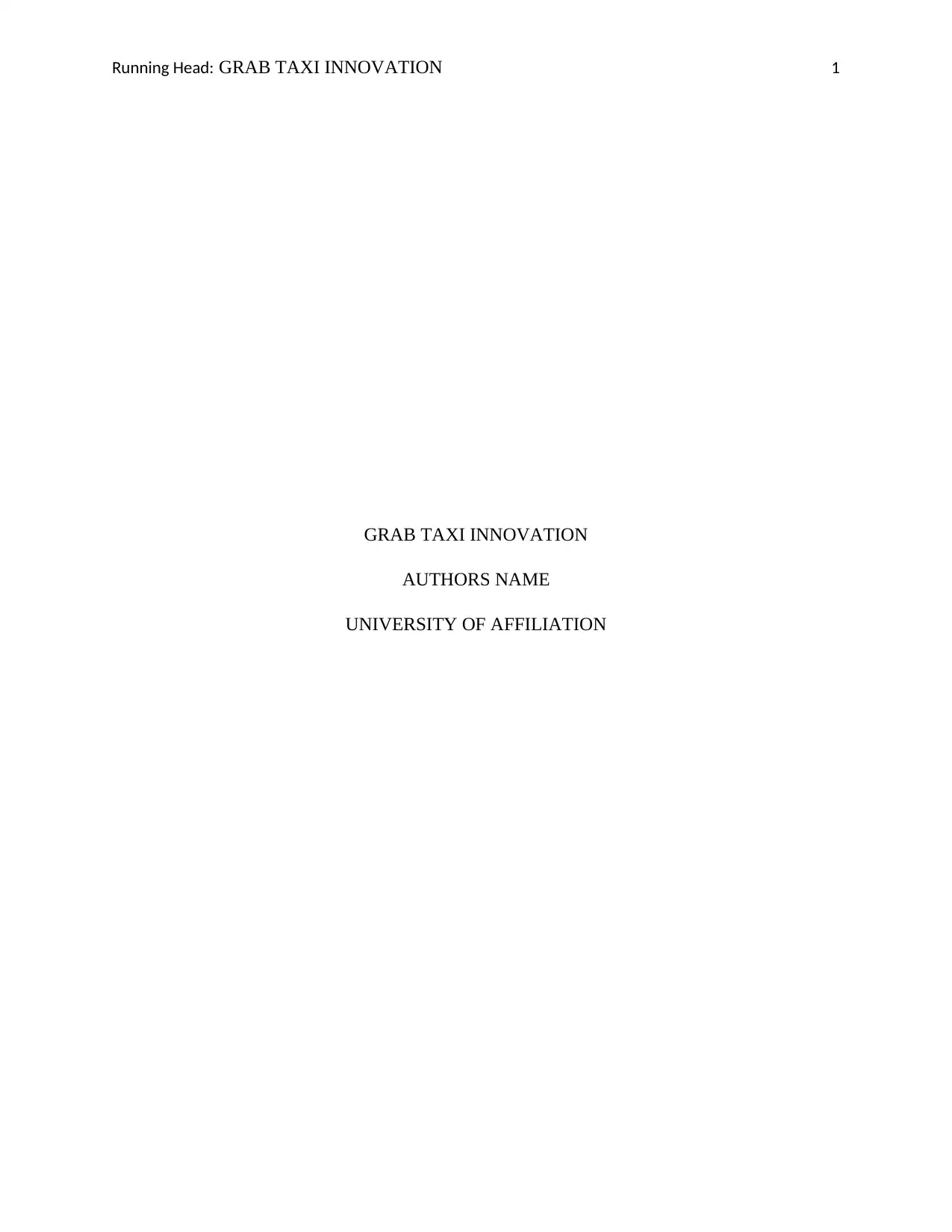
Running Head: GRAB TAXI INNOVATION 1
GRAB TAXI INNOVATION
AUTHORS NAME
UNIVERSITY OF AFFILIATION
GRAB TAXI INNOVATION
AUTHORS NAME
UNIVERSITY OF AFFILIATION
Paraphrase This Document
Need a fresh take? Get an instant paraphrase of this document with our AI Paraphraser
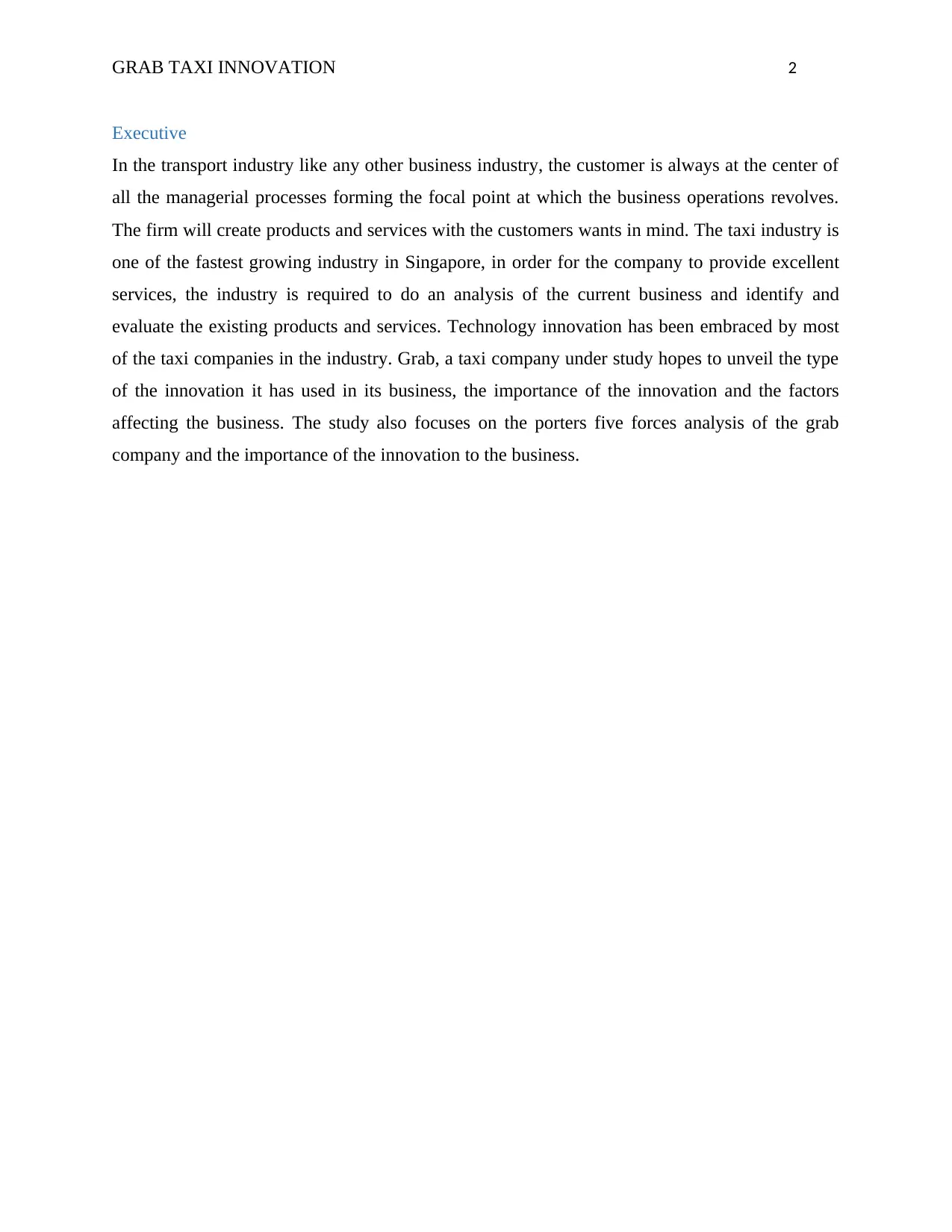
GRAB TAXI INNOVATION 2
Executive
In the transport industry like any other business industry, the customer is always at the center of
all the managerial processes forming the focal point at which the business operations revolves.
The firm will create products and services with the customers wants in mind. The taxi industry is
one of the fastest growing industry in Singapore, in order for the company to provide excellent
services, the industry is required to do an analysis of the current business and identify and
evaluate the existing products and services. Technology innovation has been embraced by most
of the taxi companies in the industry. Grab, a taxi company under study hopes to unveil the type
of the innovation it has used in its business, the importance of the innovation and the factors
affecting the business. The study also focuses on the porters five forces analysis of the grab
company and the importance of the innovation to the business.
Executive
In the transport industry like any other business industry, the customer is always at the center of
all the managerial processes forming the focal point at which the business operations revolves.
The firm will create products and services with the customers wants in mind. The taxi industry is
one of the fastest growing industry in Singapore, in order for the company to provide excellent
services, the industry is required to do an analysis of the current business and identify and
evaluate the existing products and services. Technology innovation has been embraced by most
of the taxi companies in the industry. Grab, a taxi company under study hopes to unveil the type
of the innovation it has used in its business, the importance of the innovation and the factors
affecting the business. The study also focuses on the porters five forces analysis of the grab
company and the importance of the innovation to the business.
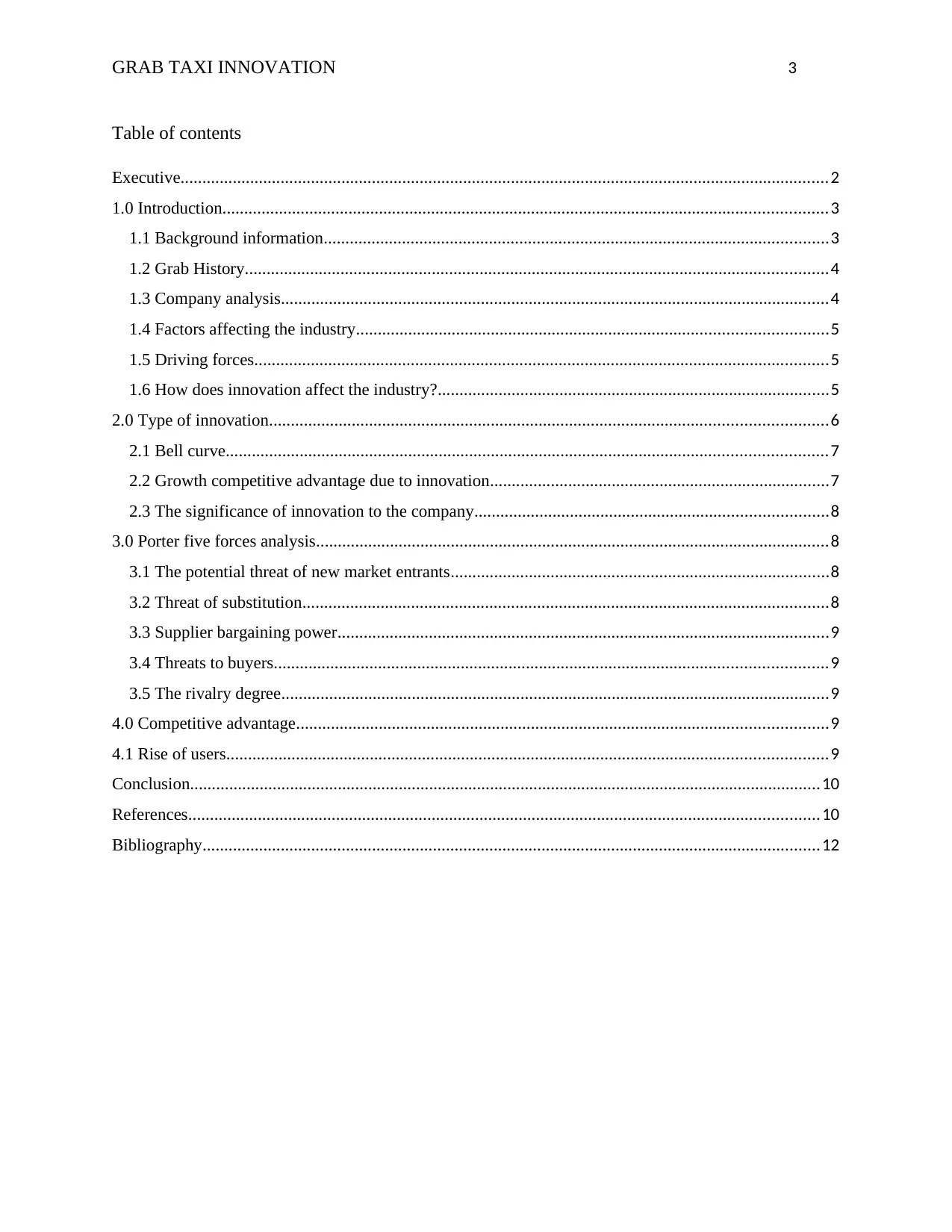
GRAB TAXI INNOVATION 3
Table of contents
Executive.....................................................................................................................................................2
1.0 Introduction...........................................................................................................................................3
1.1 Background information....................................................................................................................3
1.2 Grab History......................................................................................................................................4
1.3 Company analysis..............................................................................................................................4
1.4 Factors affecting the industry............................................................................................................5
1.5 Driving forces....................................................................................................................................5
1.6 How does innovation affect the industry?..........................................................................................5
2.0 Type of innovation................................................................................................................................6
2.1 Bell curve..........................................................................................................................................7
2.2 Growth competitive advantage due to innovation..............................................................................7
2.3 The significance of innovation to the company.................................................................................8
3.0 Porter five forces analysis......................................................................................................................8
3.1 The potential threat of new market entrants.......................................................................................8
3.2 Threat of substitution.........................................................................................................................8
3.3 Supplier bargaining power.................................................................................................................9
3.4 Threats to buyers...............................................................................................................................9
3.5 The rivalry degree..............................................................................................................................9
4.0 Competitive advantage..........................................................................................................................9
4.1 Rise of users..........................................................................................................................................9
Conclusion.................................................................................................................................................10
References.................................................................................................................................................10
Bibliography..............................................................................................................................................12
Table of contents
Executive.....................................................................................................................................................2
1.0 Introduction...........................................................................................................................................3
1.1 Background information....................................................................................................................3
1.2 Grab History......................................................................................................................................4
1.3 Company analysis..............................................................................................................................4
1.4 Factors affecting the industry............................................................................................................5
1.5 Driving forces....................................................................................................................................5
1.6 How does innovation affect the industry?..........................................................................................5
2.0 Type of innovation................................................................................................................................6
2.1 Bell curve..........................................................................................................................................7
2.2 Growth competitive advantage due to innovation..............................................................................7
2.3 The significance of innovation to the company.................................................................................8
3.0 Porter five forces analysis......................................................................................................................8
3.1 The potential threat of new market entrants.......................................................................................8
3.2 Threat of substitution.........................................................................................................................8
3.3 Supplier bargaining power.................................................................................................................9
3.4 Threats to buyers...............................................................................................................................9
3.5 The rivalry degree..............................................................................................................................9
4.0 Competitive advantage..........................................................................................................................9
4.1 Rise of users..........................................................................................................................................9
Conclusion.................................................................................................................................................10
References.................................................................................................................................................10
Bibliography..............................................................................................................................................12
⊘ This is a preview!⊘
Do you want full access?
Subscribe today to unlock all pages.

Trusted by 1+ million students worldwide
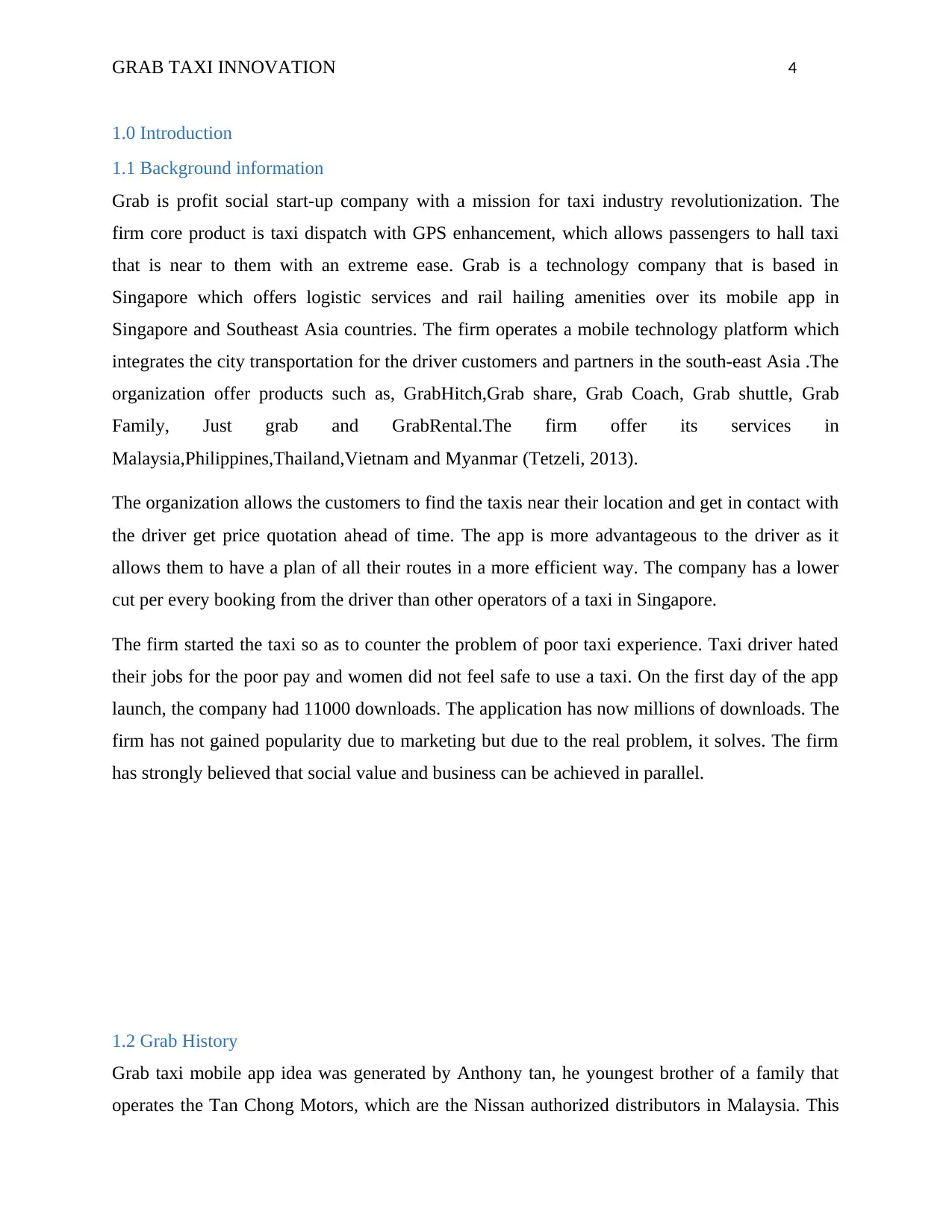
GRAB TAXI INNOVATION 4
1.0 Introduction
1.1 Background information
Grab is profit social start-up company with a mission for taxi industry revolutionization. The
firm core product is taxi dispatch with GPS enhancement, which allows passengers to hall taxi
that is near to them with an extreme ease. Grab is a technology company that is based in
Singapore which offers logistic services and rail hailing amenities over its mobile app in
Singapore and Southeast Asia countries. The firm operates a mobile technology platform which
integrates the city transportation for the driver customers and partners in the south-east Asia .The
organization offer products such as, GrabHitch,Grab share, Grab Coach, Grab shuttle, Grab
Family, Just grab and GrabRental.The firm offer its services in
Malaysia,Philippines,Thailand,Vietnam and Myanmar (Tetzeli, 2013).
The organization allows the customers to find the taxis near their location and get in contact with
the driver get price quotation ahead of time. The app is more advantageous to the driver as it
allows them to have a plan of all their routes in a more efficient way. The company has a lower
cut per every booking from the driver than other operators of a taxi in Singapore.
The firm started the taxi so as to counter the problem of poor taxi experience. Taxi driver hated
their jobs for the poor pay and women did not feel safe to use a taxi. On the first day of the app
launch, the company had 11000 downloads. The application has now millions of downloads. The
firm has not gained popularity due to marketing but due to the real problem, it solves. The firm
has strongly believed that social value and business can be achieved in parallel.
1.2 Grab History
Grab taxi mobile app idea was generated by Anthony tan, he youngest brother of a family that
operates the Tan Chong Motors, which are the Nissan authorized distributors in Malaysia. This
1.0 Introduction
1.1 Background information
Grab is profit social start-up company with a mission for taxi industry revolutionization. The
firm core product is taxi dispatch with GPS enhancement, which allows passengers to hall taxi
that is near to them with an extreme ease. Grab is a technology company that is based in
Singapore which offers logistic services and rail hailing amenities over its mobile app in
Singapore and Southeast Asia countries. The firm operates a mobile technology platform which
integrates the city transportation for the driver customers and partners in the south-east Asia .The
organization offer products such as, GrabHitch,Grab share, Grab Coach, Grab shuttle, Grab
Family, Just grab and GrabRental.The firm offer its services in
Malaysia,Philippines,Thailand,Vietnam and Myanmar (Tetzeli, 2013).
The organization allows the customers to find the taxis near their location and get in contact with
the driver get price quotation ahead of time. The app is more advantageous to the driver as it
allows them to have a plan of all their routes in a more efficient way. The company has a lower
cut per every booking from the driver than other operators of a taxi in Singapore.
The firm started the taxi so as to counter the problem of poor taxi experience. Taxi driver hated
their jobs for the poor pay and women did not feel safe to use a taxi. On the first day of the app
launch, the company had 11000 downloads. The application has now millions of downloads. The
firm has not gained popularity due to marketing but due to the real problem, it solves. The firm
has strongly believed that social value and business can be achieved in parallel.
1.2 Grab History
Grab taxi mobile app idea was generated by Anthony tan, he youngest brother of a family that
operates the Tan Chong Motors, which are the Nissan authorized distributors in Malaysia. This
Paraphrase This Document
Need a fresh take? Get an instant paraphrase of this document with our AI Paraphraser
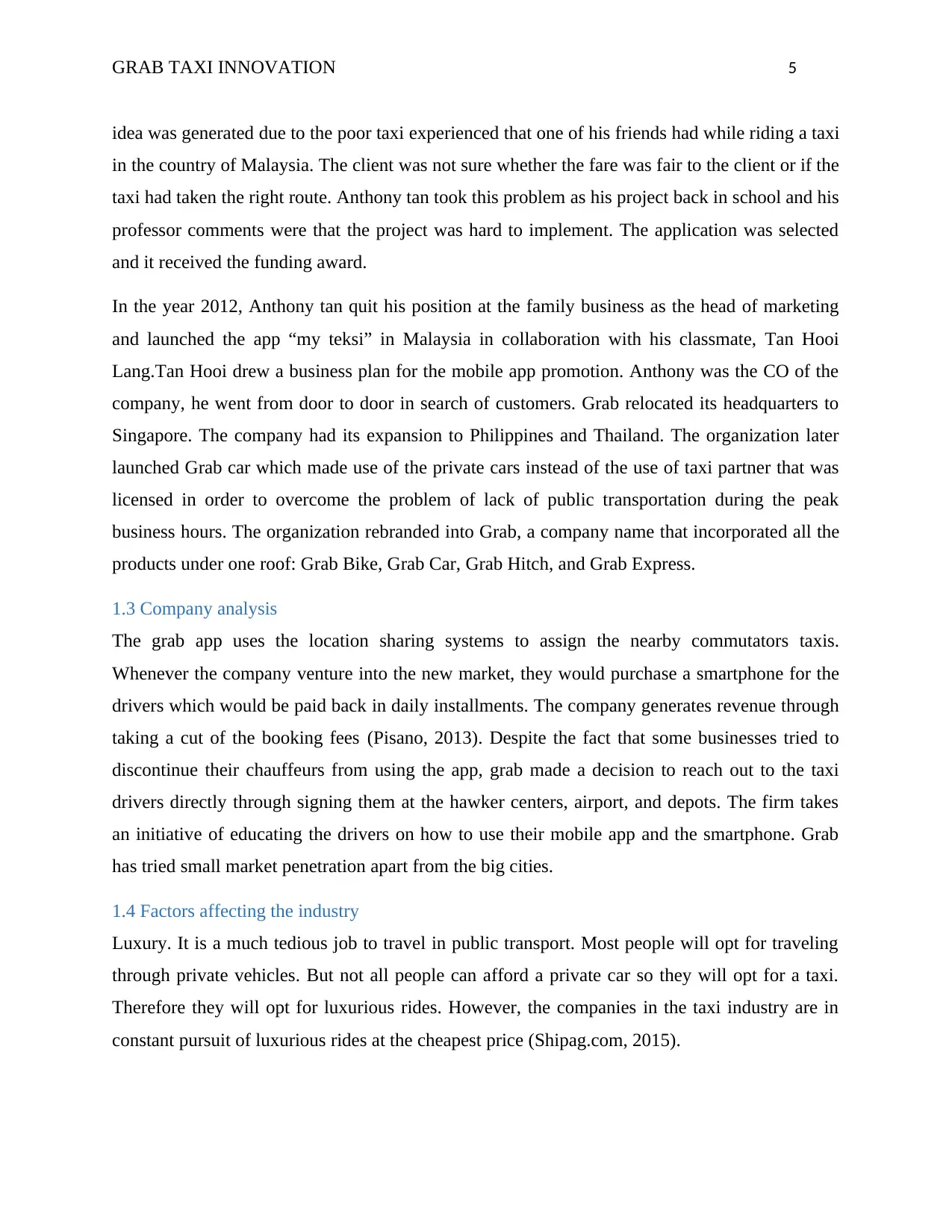
GRAB TAXI INNOVATION 5
idea was generated due to the poor taxi experienced that one of his friends had while riding a taxi
in the country of Malaysia. The client was not sure whether the fare was fair to the client or if the
taxi had taken the right route. Anthony tan took this problem as his project back in school and his
professor comments were that the project was hard to implement. The application was selected
and it received the funding award.
In the year 2012, Anthony tan quit his position at the family business as the head of marketing
and launched the app “my teksi” in Malaysia in collaboration with his classmate, Tan Hooi
Lang.Tan Hooi drew a business plan for the mobile app promotion. Anthony was the CO of the
company, he went from door to door in search of customers. Grab relocated its headquarters to
Singapore. The company had its expansion to Philippines and Thailand. The organization later
launched Grab car which made use of the private cars instead of the use of taxi partner that was
licensed in order to overcome the problem of lack of public transportation during the peak
business hours. The organization rebranded into Grab, a company name that incorporated all the
products under one roof: Grab Bike, Grab Car, Grab Hitch, and Grab Express.
1.3 Company analysis
The grab app uses the location sharing systems to assign the nearby commutators taxis.
Whenever the company venture into the new market, they would purchase a smartphone for the
drivers which would be paid back in daily installments. The company generates revenue through
taking a cut of the booking fees (Pisano, 2013). Despite the fact that some businesses tried to
discontinue their chauffeurs from using the app, grab made a decision to reach out to the taxi
drivers directly through signing them at the hawker centers, airport, and depots. The firm takes
an initiative of educating the drivers on how to use their mobile app and the smartphone. Grab
has tried small market penetration apart from the big cities.
1.4 Factors affecting the industry
Luxury. It is a much tedious job to travel in public transport. Most people will opt for traveling
through private vehicles. But not all people can afford a private car so they will opt for a taxi.
Therefore they will opt for luxurious rides. However, the companies in the taxi industry are in
constant pursuit of luxurious rides at the cheapest price (Shipag.com, 2015).
idea was generated due to the poor taxi experienced that one of his friends had while riding a taxi
in the country of Malaysia. The client was not sure whether the fare was fair to the client or if the
taxi had taken the right route. Anthony tan took this problem as his project back in school and his
professor comments were that the project was hard to implement. The application was selected
and it received the funding award.
In the year 2012, Anthony tan quit his position at the family business as the head of marketing
and launched the app “my teksi” in Malaysia in collaboration with his classmate, Tan Hooi
Lang.Tan Hooi drew a business plan for the mobile app promotion. Anthony was the CO of the
company, he went from door to door in search of customers. Grab relocated its headquarters to
Singapore. The company had its expansion to Philippines and Thailand. The organization later
launched Grab car which made use of the private cars instead of the use of taxi partner that was
licensed in order to overcome the problem of lack of public transportation during the peak
business hours. The organization rebranded into Grab, a company name that incorporated all the
products under one roof: Grab Bike, Grab Car, Grab Hitch, and Grab Express.
1.3 Company analysis
The grab app uses the location sharing systems to assign the nearby commutators taxis.
Whenever the company venture into the new market, they would purchase a smartphone for the
drivers which would be paid back in daily installments. The company generates revenue through
taking a cut of the booking fees (Pisano, 2013). Despite the fact that some businesses tried to
discontinue their chauffeurs from using the app, grab made a decision to reach out to the taxi
drivers directly through signing them at the hawker centers, airport, and depots. The firm takes
an initiative of educating the drivers on how to use their mobile app and the smartphone. Grab
has tried small market penetration apart from the big cities.
1.4 Factors affecting the industry
Luxury. It is a much tedious job to travel in public transport. Most people will opt for traveling
through private vehicles. But not all people can afford a private car so they will opt for a taxi.
Therefore they will opt for luxurious rides. However, the companies in the taxi industry are in
constant pursuit of luxurious rides at the cheapest price (Shipag.com, 2015).
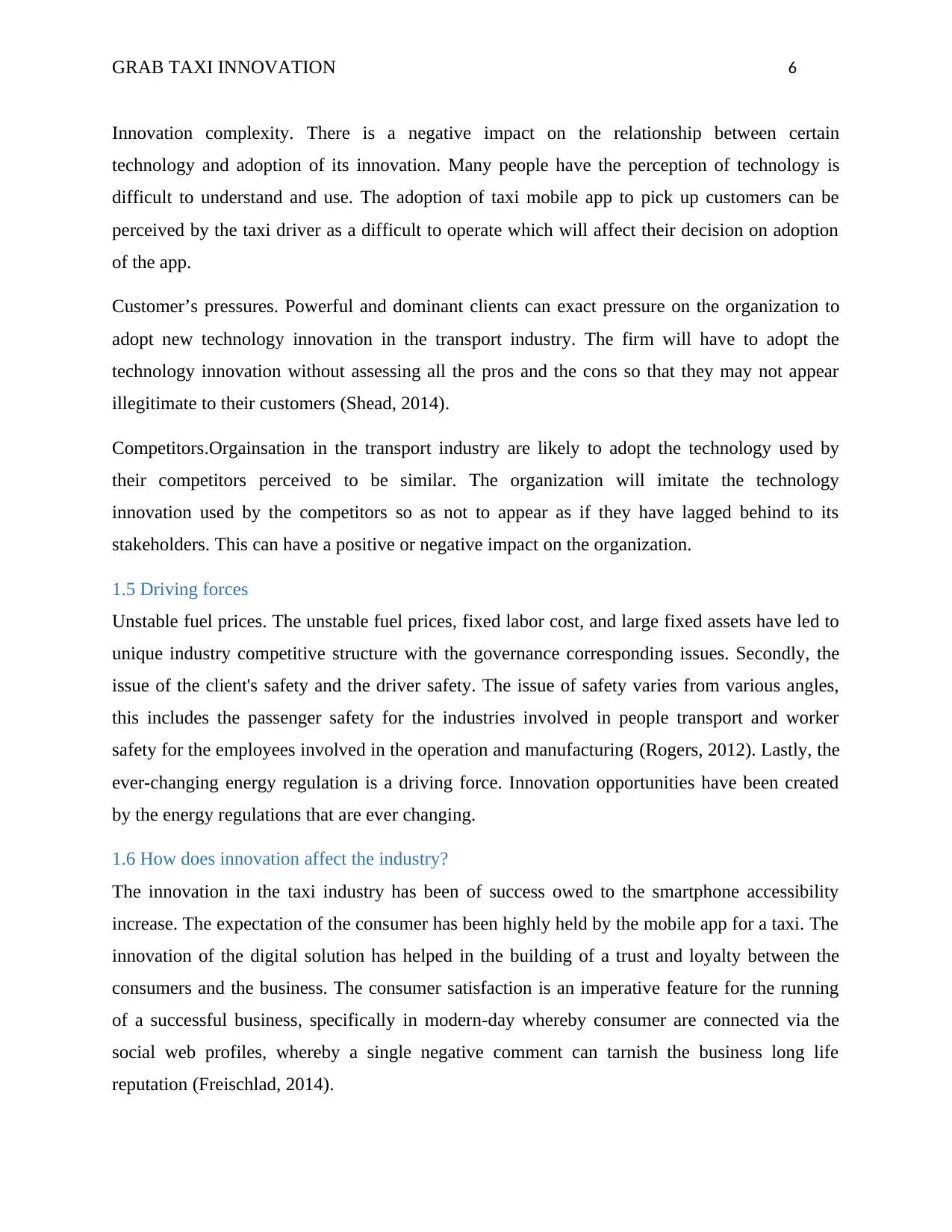
GRAB TAXI INNOVATION 6
Innovation complexity. There is a negative impact on the relationship between certain
technology and adoption of its innovation. Many people have the perception of technology is
difficult to understand and use. The adoption of taxi mobile app to pick up customers can be
perceived by the taxi driver as a difficult to operate which will affect their decision on adoption
of the app.
Customer’s pressures. Powerful and dominant clients can exact pressure on the organization to
adopt new technology innovation in the transport industry. The firm will have to adopt the
technology innovation without assessing all the pros and the cons so that they may not appear
illegitimate to their customers (Shead, 2014).
Competitors.Orgainsation in the transport industry are likely to adopt the technology used by
their competitors perceived to be similar. The organization will imitate the technology
innovation used by the competitors so as not to appear as if they have lagged behind to its
stakeholders. This can have a positive or negative impact on the organization.
1.5 Driving forces
Unstable fuel prices. The unstable fuel prices, fixed labor cost, and large fixed assets have led to
unique industry competitive structure with the governance corresponding issues. Secondly, the
issue of the client's safety and the driver safety. The issue of safety varies from various angles,
this includes the passenger safety for the industries involved in people transport and worker
safety for the employees involved in the operation and manufacturing (Rogers, 2012). Lastly, the
ever-changing energy regulation is a driving force. Innovation opportunities have been created
by the energy regulations that are ever changing.
1.6 How does innovation affect the industry?
The innovation in the taxi industry has been of success owed to the smartphone accessibility
increase. The expectation of the consumer has been highly held by the mobile app for a taxi. The
innovation of the digital solution has helped in the building of a trust and loyalty between the
consumers and the business. The consumer satisfaction is an imperative feature for the running
of a successful business, specifically in modern-day whereby consumer are connected via the
social web profiles, whereby a single negative comment can tarnish the business long life
reputation (Freischlad, 2014).
Innovation complexity. There is a negative impact on the relationship between certain
technology and adoption of its innovation. Many people have the perception of technology is
difficult to understand and use. The adoption of taxi mobile app to pick up customers can be
perceived by the taxi driver as a difficult to operate which will affect their decision on adoption
of the app.
Customer’s pressures. Powerful and dominant clients can exact pressure on the organization to
adopt new technology innovation in the transport industry. The firm will have to adopt the
technology innovation without assessing all the pros and the cons so that they may not appear
illegitimate to their customers (Shead, 2014).
Competitors.Orgainsation in the transport industry are likely to adopt the technology used by
their competitors perceived to be similar. The organization will imitate the technology
innovation used by the competitors so as not to appear as if they have lagged behind to its
stakeholders. This can have a positive or negative impact on the organization.
1.5 Driving forces
Unstable fuel prices. The unstable fuel prices, fixed labor cost, and large fixed assets have led to
unique industry competitive structure with the governance corresponding issues. Secondly, the
issue of the client's safety and the driver safety. The issue of safety varies from various angles,
this includes the passenger safety for the industries involved in people transport and worker
safety for the employees involved in the operation and manufacturing (Rogers, 2012). Lastly, the
ever-changing energy regulation is a driving force. Innovation opportunities have been created
by the energy regulations that are ever changing.
1.6 How does innovation affect the industry?
The innovation in the taxi industry has been of success owed to the smartphone accessibility
increase. The expectation of the consumer has been highly held by the mobile app for a taxi. The
innovation of the digital solution has helped in the building of a trust and loyalty between the
consumers and the business. The consumer satisfaction is an imperative feature for the running
of a successful business, specifically in modern-day whereby consumer are connected via the
social web profiles, whereby a single negative comment can tarnish the business long life
reputation (Freischlad, 2014).
⊘ This is a preview!⊘
Do you want full access?
Subscribe today to unlock all pages.

Trusted by 1+ million students worldwide
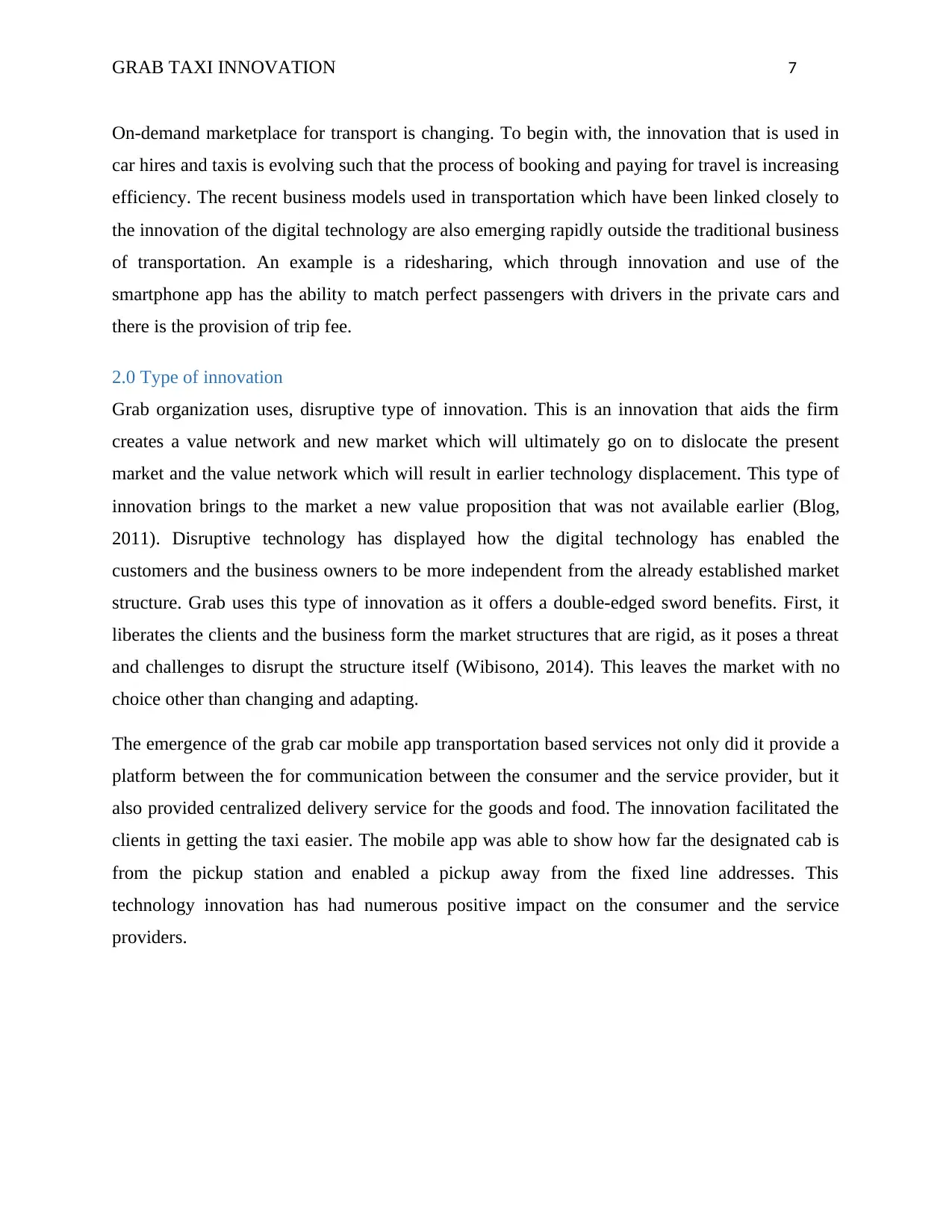
GRAB TAXI INNOVATION 7
On-demand marketplace for transport is changing. To begin with, the innovation that is used in
car hires and taxis is evolving such that the process of booking and paying for travel is increasing
efficiency. The recent business models used in transportation which have been linked closely to
the innovation of the digital technology are also emerging rapidly outside the traditional business
of transportation. An example is a ridesharing, which through innovation and use of the
smartphone app has the ability to match perfect passengers with drivers in the private cars and
there is the provision of trip fee.
2.0 Type of innovation
Grab organization uses, disruptive type of innovation. This is an innovation that aids the firm
creates a value network and new market which will ultimately go on to dislocate the present
market and the value network which will result in earlier technology displacement. This type of
innovation brings to the market a new value proposition that was not available earlier (Blog,
2011). Disruptive technology has displayed how the digital technology has enabled the
customers and the business owners to be more independent from the already established market
structure. Grab uses this type of innovation as it offers a double-edged sword benefits. First, it
liberates the clients and the business form the market structures that are rigid, as it poses a threat
and challenges to disrupt the structure itself (Wibisono, 2014). This leaves the market with no
choice other than changing and adapting.
The emergence of the grab car mobile app transportation based services not only did it provide a
platform between the for communication between the consumer and the service provider, but it
also provided centralized delivery service for the goods and food. The innovation facilitated the
clients in getting the taxi easier. The mobile app was able to show how far the designated cab is
from the pickup station and enabled a pickup away from the fixed line addresses. This
technology innovation has had numerous positive impact on the consumer and the service
providers.
On-demand marketplace for transport is changing. To begin with, the innovation that is used in
car hires and taxis is evolving such that the process of booking and paying for travel is increasing
efficiency. The recent business models used in transportation which have been linked closely to
the innovation of the digital technology are also emerging rapidly outside the traditional business
of transportation. An example is a ridesharing, which through innovation and use of the
smartphone app has the ability to match perfect passengers with drivers in the private cars and
there is the provision of trip fee.
2.0 Type of innovation
Grab organization uses, disruptive type of innovation. This is an innovation that aids the firm
creates a value network and new market which will ultimately go on to dislocate the present
market and the value network which will result in earlier technology displacement. This type of
innovation brings to the market a new value proposition that was not available earlier (Blog,
2011). Disruptive technology has displayed how the digital technology has enabled the
customers and the business owners to be more independent from the already established market
structure. Grab uses this type of innovation as it offers a double-edged sword benefits. First, it
liberates the clients and the business form the market structures that are rigid, as it poses a threat
and challenges to disrupt the structure itself (Wibisono, 2014). This leaves the market with no
choice other than changing and adapting.
The emergence of the grab car mobile app transportation based services not only did it provide a
platform between the for communication between the consumer and the service provider, but it
also provided centralized delivery service for the goods and food. The innovation facilitated the
clients in getting the taxi easier. The mobile app was able to show how far the designated cab is
from the pickup station and enabled a pickup away from the fixed line addresses. This
technology innovation has had numerous positive impact on the consumer and the service
providers.
Paraphrase This Document
Need a fresh take? Get an instant paraphrase of this document with our AI Paraphraser
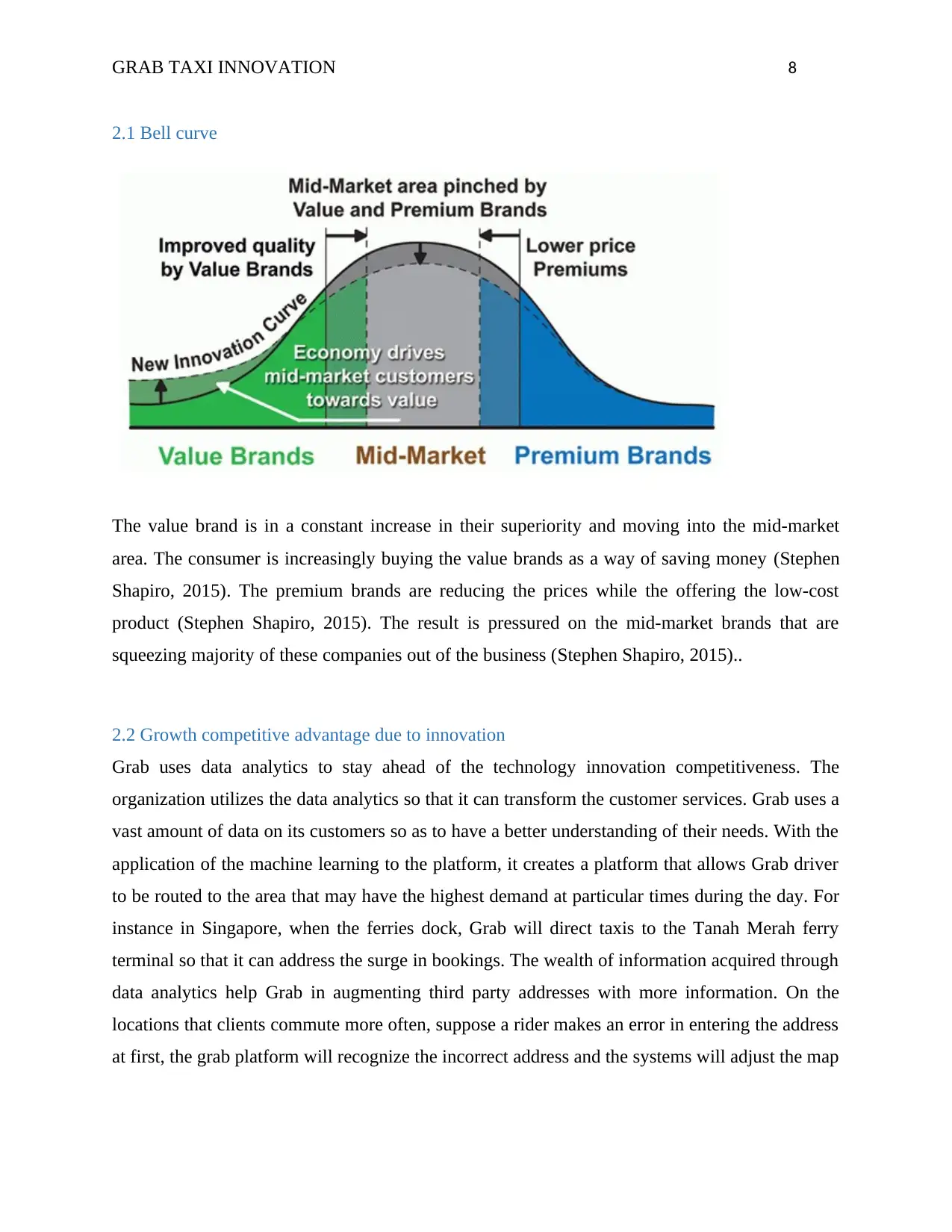
GRAB TAXI INNOVATION 8
2.1 Bell curve
The value brand is in a constant increase in their superiority and moving into the mid-market
area. The consumer is increasingly buying the value brands as a way of saving money (Stephen
Shapiro, 2015). The premium brands are reducing the prices while the offering the low-cost
product (Stephen Shapiro, 2015). The result is pressured on the mid-market brands that are
squeezing majority of these companies out of the business (Stephen Shapiro, 2015)..
2.2 Growth competitive advantage due to innovation
Grab uses data analytics to stay ahead of the technology innovation competitiveness. The
organization utilizes the data analytics so that it can transform the customer services. Grab uses a
vast amount of data on its customers so as to have a better understanding of their needs. With the
application of the machine learning to the platform, it creates a platform that allows Grab driver
to be routed to the area that may have the highest demand at particular times during the day. For
instance in Singapore, when the ferries dock, Grab will direct taxis to the Tanah Merah ferry
terminal so that it can address the surge in bookings. The wealth of information acquired through
data analytics help Grab in augmenting third party addresses with more information. On the
locations that clients commute more often, suppose a rider makes an error in entering the address
at first, the grab platform will recognize the incorrect address and the systems will adjust the map
2.1 Bell curve
The value brand is in a constant increase in their superiority and moving into the mid-market
area. The consumer is increasingly buying the value brands as a way of saving money (Stephen
Shapiro, 2015). The premium brands are reducing the prices while the offering the low-cost
product (Stephen Shapiro, 2015). The result is pressured on the mid-market brands that are
squeezing majority of these companies out of the business (Stephen Shapiro, 2015)..
2.2 Growth competitive advantage due to innovation
Grab uses data analytics to stay ahead of the technology innovation competitiveness. The
organization utilizes the data analytics so that it can transform the customer services. Grab uses a
vast amount of data on its customers so as to have a better understanding of their needs. With the
application of the machine learning to the platform, it creates a platform that allows Grab driver
to be routed to the area that may have the highest demand at particular times during the day. For
instance in Singapore, when the ferries dock, Grab will direct taxis to the Tanah Merah ferry
terminal so that it can address the surge in bookings. The wealth of information acquired through
data analytics help Grab in augmenting third party addresses with more information. On the
locations that clients commute more often, suppose a rider makes an error in entering the address
at first, the grab platform will recognize the incorrect address and the systems will adjust the map
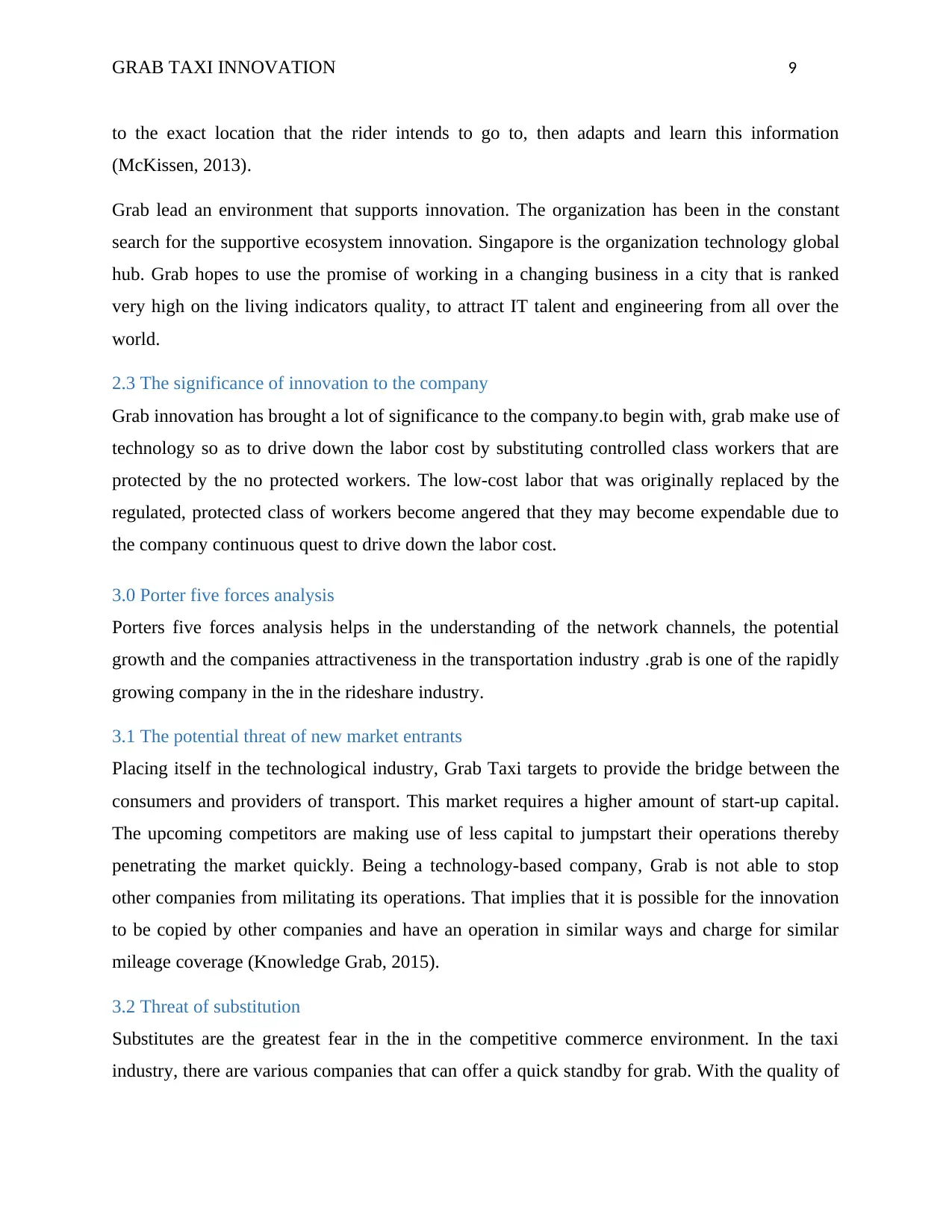
GRAB TAXI INNOVATION 9
to the exact location that the rider intends to go to, then adapts and learn this information
(McKissen, 2013).
Grab lead an environment that supports innovation. The organization has been in the constant
search for the supportive ecosystem innovation. Singapore is the organization technology global
hub. Grab hopes to use the promise of working in a changing business in a city that is ranked
very high on the living indicators quality, to attract IT talent and engineering from all over the
world.
2.3 The significance of innovation to the company
Grab innovation has brought a lot of significance to the company.to begin with, grab make use of
technology so as to drive down the labor cost by substituting controlled class workers that are
protected by the no protected workers. The low-cost labor that was originally replaced by the
regulated, protected class of workers become angered that they may become expendable due to
the company continuous quest to drive down the labor cost.
3.0 Porter five forces analysis
Porters five forces analysis helps in the understanding of the network channels, the potential
growth and the companies attractiveness in the transportation industry .grab is one of the rapidly
growing company in the in the rideshare industry.
3.1 The potential threat of new market entrants
Placing itself in the technological industry, Grab Taxi targets to provide the bridge between the
consumers and providers of transport. This market requires a higher amount of start-up capital.
The upcoming competitors are making use of less capital to jumpstart their operations thereby
penetrating the market quickly. Being a technology-based company, Grab is not able to stop
other companies from militating its operations. That implies that it is possible for the innovation
to be copied by other companies and have an operation in similar ways and charge for similar
mileage coverage (Knowledge Grab, 2015).
3.2 Threat of substitution
Substitutes are the greatest fear in the in the competitive commerce environment. In the taxi
industry, there are various companies that can offer a quick standby for grab. With the quality of
to the exact location that the rider intends to go to, then adapts and learn this information
(McKissen, 2013).
Grab lead an environment that supports innovation. The organization has been in the constant
search for the supportive ecosystem innovation. Singapore is the organization technology global
hub. Grab hopes to use the promise of working in a changing business in a city that is ranked
very high on the living indicators quality, to attract IT talent and engineering from all over the
world.
2.3 The significance of innovation to the company
Grab innovation has brought a lot of significance to the company.to begin with, grab make use of
technology so as to drive down the labor cost by substituting controlled class workers that are
protected by the no protected workers. The low-cost labor that was originally replaced by the
regulated, protected class of workers become angered that they may become expendable due to
the company continuous quest to drive down the labor cost.
3.0 Porter five forces analysis
Porters five forces analysis helps in the understanding of the network channels, the potential
growth and the companies attractiveness in the transportation industry .grab is one of the rapidly
growing company in the in the rideshare industry.
3.1 The potential threat of new market entrants
Placing itself in the technological industry, Grab Taxi targets to provide the bridge between the
consumers and providers of transport. This market requires a higher amount of start-up capital.
The upcoming competitors are making use of less capital to jumpstart their operations thereby
penetrating the market quickly. Being a technology-based company, Grab is not able to stop
other companies from militating its operations. That implies that it is possible for the innovation
to be copied by other companies and have an operation in similar ways and charge for similar
mileage coverage (Knowledge Grab, 2015).
3.2 Threat of substitution
Substitutes are the greatest fear in the in the competitive commerce environment. In the taxi
industry, there are various companies that can offer a quick standby for grab. With the quality of
⊘ This is a preview!⊘
Do you want full access?
Subscribe today to unlock all pages.

Trusted by 1+ million students worldwide
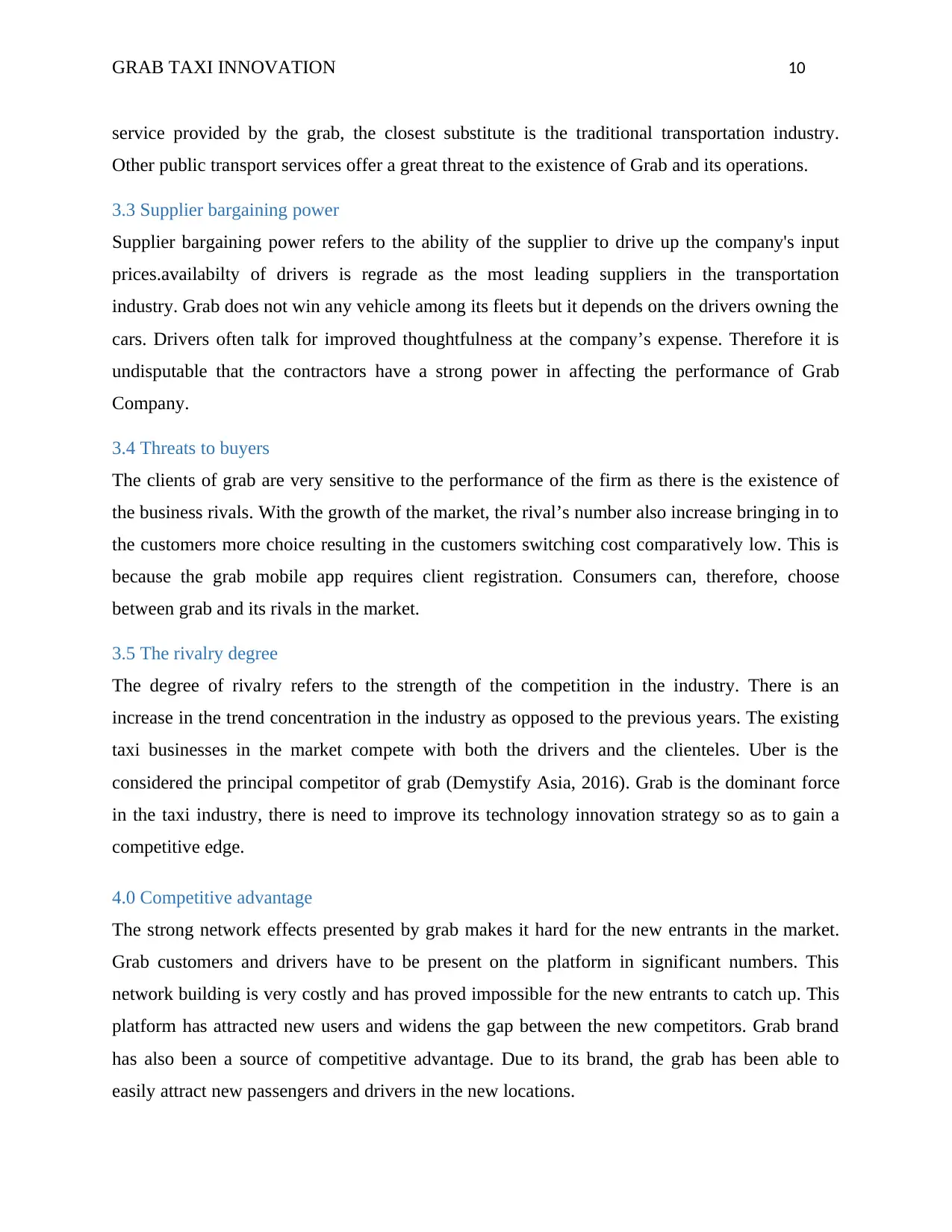
GRAB TAXI INNOVATION 10
service provided by the grab, the closest substitute is the traditional transportation industry.
Other public transport services offer a great threat to the existence of Grab and its operations.
3.3 Supplier bargaining power
Supplier bargaining power refers to the ability of the supplier to drive up the company's input
prices.availabilty of drivers is regrade as the most leading suppliers in the transportation
industry. Grab does not win any vehicle among its fleets but it depends on the drivers owning the
cars. Drivers often talk for improved thoughtfulness at the company’s expense. Therefore it is
undisputable that the contractors have a strong power in affecting the performance of Grab
Company.
3.4 Threats to buyers
The clients of grab are very sensitive to the performance of the firm as there is the existence of
the business rivals. With the growth of the market, the rival’s number also increase bringing in to
the customers more choice resulting in the customers switching cost comparatively low. This is
because the grab mobile app requires client registration. Consumers can, therefore, choose
between grab and its rivals in the market.
3.5 The rivalry degree
The degree of rivalry refers to the strength of the competition in the industry. There is an
increase in the trend concentration in the industry as opposed to the previous years. The existing
taxi businesses in the market compete with both the drivers and the clienteles. Uber is the
considered the principal competitor of grab (Demystify Asia, 2016). Grab is the dominant force
in the taxi industry, there is need to improve its technology innovation strategy so as to gain a
competitive edge.
4.0 Competitive advantage
The strong network effects presented by grab makes it hard for the new entrants in the market.
Grab customers and drivers have to be present on the platform in significant numbers. This
network building is very costly and has proved impossible for the new entrants to catch up. This
platform has attracted new users and widens the gap between the new competitors. Grab brand
has also been a source of competitive advantage. Due to its brand, the grab has been able to
easily attract new passengers and drivers in the new locations.
service provided by the grab, the closest substitute is the traditional transportation industry.
Other public transport services offer a great threat to the existence of Grab and its operations.
3.3 Supplier bargaining power
Supplier bargaining power refers to the ability of the supplier to drive up the company's input
prices.availabilty of drivers is regrade as the most leading suppliers in the transportation
industry. Grab does not win any vehicle among its fleets but it depends on the drivers owning the
cars. Drivers often talk for improved thoughtfulness at the company’s expense. Therefore it is
undisputable that the contractors have a strong power in affecting the performance of Grab
Company.
3.4 Threats to buyers
The clients of grab are very sensitive to the performance of the firm as there is the existence of
the business rivals. With the growth of the market, the rival’s number also increase bringing in to
the customers more choice resulting in the customers switching cost comparatively low. This is
because the grab mobile app requires client registration. Consumers can, therefore, choose
between grab and its rivals in the market.
3.5 The rivalry degree
The degree of rivalry refers to the strength of the competition in the industry. There is an
increase in the trend concentration in the industry as opposed to the previous years. The existing
taxi businesses in the market compete with both the drivers and the clienteles. Uber is the
considered the principal competitor of grab (Demystify Asia, 2016). Grab is the dominant force
in the taxi industry, there is need to improve its technology innovation strategy so as to gain a
competitive edge.
4.0 Competitive advantage
The strong network effects presented by grab makes it hard for the new entrants in the market.
Grab customers and drivers have to be present on the platform in significant numbers. This
network building is very costly and has proved impossible for the new entrants to catch up. This
platform has attracted new users and widens the gap between the new competitors. Grab brand
has also been a source of competitive advantage. Due to its brand, the grab has been able to
easily attract new passengers and drivers in the new locations.
Paraphrase This Document
Need a fresh take? Get an instant paraphrase of this document with our AI Paraphraser
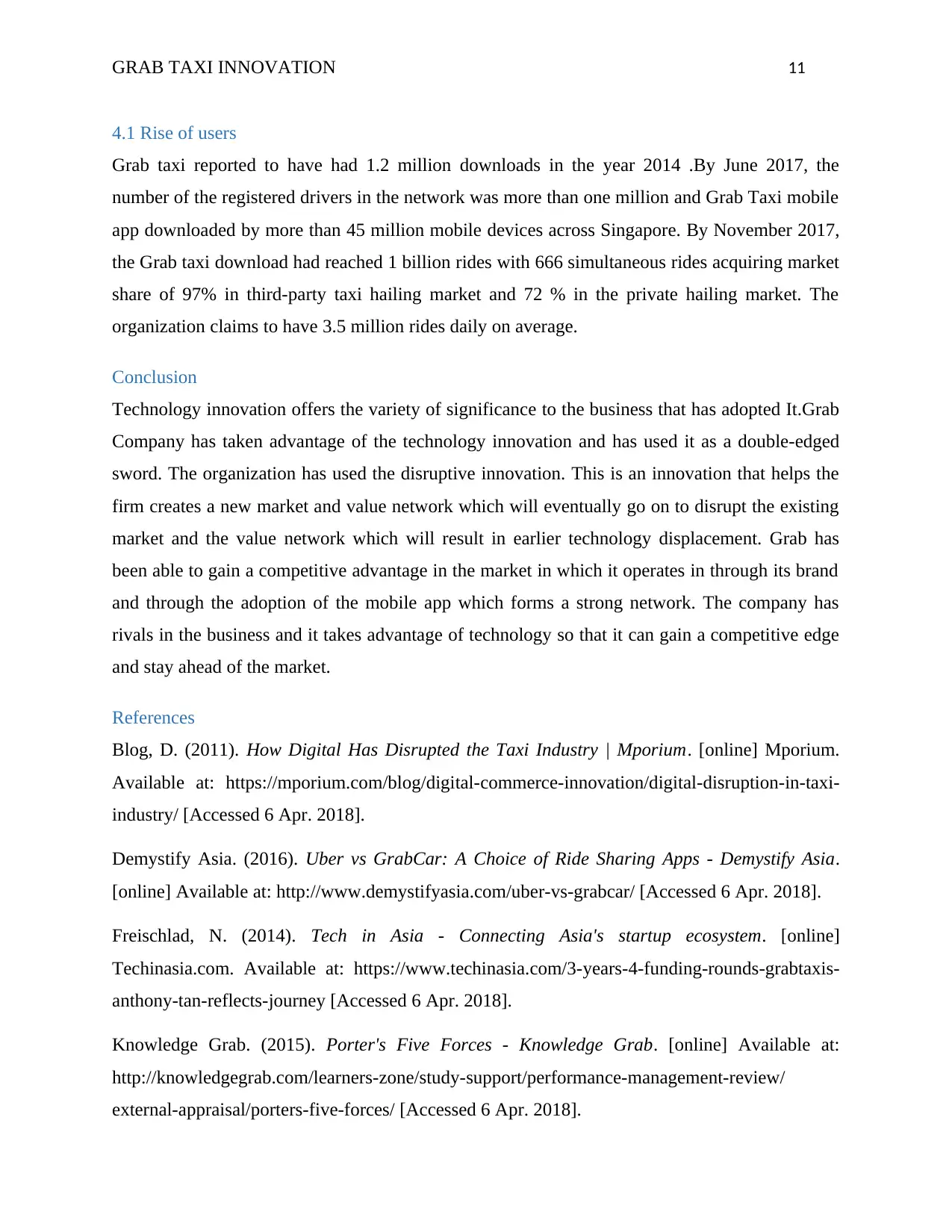
GRAB TAXI INNOVATION 11
4.1 Rise of users
Grab taxi reported to have had 1.2 million downloads in the year 2014 .By June 2017, the
number of the registered drivers in the network was more than one million and Grab Taxi mobile
app downloaded by more than 45 million mobile devices across Singapore. By November 2017,
the Grab taxi download had reached 1 billion rides with 666 simultaneous rides acquiring market
share of 97% in third-party taxi hailing market and 72 % in the private hailing market. The
organization claims to have 3.5 million rides daily on average.
Conclusion
Technology innovation offers the variety of significance to the business that has adopted It.Grab
Company has taken advantage of the technology innovation and has used it as a double-edged
sword. The organization has used the disruptive innovation. This is an innovation that helps the
firm creates a new market and value network which will eventually go on to disrupt the existing
market and the value network which will result in earlier technology displacement. Grab has
been able to gain a competitive advantage in the market in which it operates in through its brand
and through the adoption of the mobile app which forms a strong network. The company has
rivals in the business and it takes advantage of technology so that it can gain a competitive edge
and stay ahead of the market.
References
Blog, D. (2011). How Digital Has Disrupted the Taxi Industry | Mporium. [online] Mporium.
Available at: https://mporium.com/blog/digital-commerce-innovation/digital-disruption-in-taxi-
industry/ [Accessed 6 Apr. 2018].
Demystify Asia. (2016). Uber vs GrabCar: A Choice of Ride Sharing Apps - Demystify Asia.
[online] Available at: http://www.demystifyasia.com/uber-vs-grabcar/ [Accessed 6 Apr. 2018].
Freischlad, N. (2014). Tech in Asia - Connecting Asia's startup ecosystem. [online]
Techinasia.com. Available at: https://www.techinasia.com/3-years-4-funding-rounds-grabtaxis-
anthony-tan-reflects-journey [Accessed 6 Apr. 2018].
Knowledge Grab. (2015). Porter's Five Forces - Knowledge Grab. [online] Available at:
http://knowledgegrab.com/learners-zone/study-support/performance-management-review/
external-appraisal/porters-five-forces/ [Accessed 6 Apr. 2018].
4.1 Rise of users
Grab taxi reported to have had 1.2 million downloads in the year 2014 .By June 2017, the
number of the registered drivers in the network was more than one million and Grab Taxi mobile
app downloaded by more than 45 million mobile devices across Singapore. By November 2017,
the Grab taxi download had reached 1 billion rides with 666 simultaneous rides acquiring market
share of 97% in third-party taxi hailing market and 72 % in the private hailing market. The
organization claims to have 3.5 million rides daily on average.
Conclusion
Technology innovation offers the variety of significance to the business that has adopted It.Grab
Company has taken advantage of the technology innovation and has used it as a double-edged
sword. The organization has used the disruptive innovation. This is an innovation that helps the
firm creates a new market and value network which will eventually go on to disrupt the existing
market and the value network which will result in earlier technology displacement. Grab has
been able to gain a competitive advantage in the market in which it operates in through its brand
and through the adoption of the mobile app which forms a strong network. The company has
rivals in the business and it takes advantage of technology so that it can gain a competitive edge
and stay ahead of the market.
References
Blog, D. (2011). How Digital Has Disrupted the Taxi Industry | Mporium. [online] Mporium.
Available at: https://mporium.com/blog/digital-commerce-innovation/digital-disruption-in-taxi-
industry/ [Accessed 6 Apr. 2018].
Demystify Asia. (2016). Uber vs GrabCar: A Choice of Ride Sharing Apps - Demystify Asia.
[online] Available at: http://www.demystifyasia.com/uber-vs-grabcar/ [Accessed 6 Apr. 2018].
Freischlad, N. (2014). Tech in Asia - Connecting Asia's startup ecosystem. [online]
Techinasia.com. Available at: https://www.techinasia.com/3-years-4-funding-rounds-grabtaxis-
anthony-tan-reflects-journey [Accessed 6 Apr. 2018].
Knowledge Grab. (2015). Porter's Five Forces - Knowledge Grab. [online] Available at:
http://knowledgegrab.com/learners-zone/study-support/performance-management-review/
external-appraisal/porters-five-forces/ [Accessed 6 Apr. 2018].
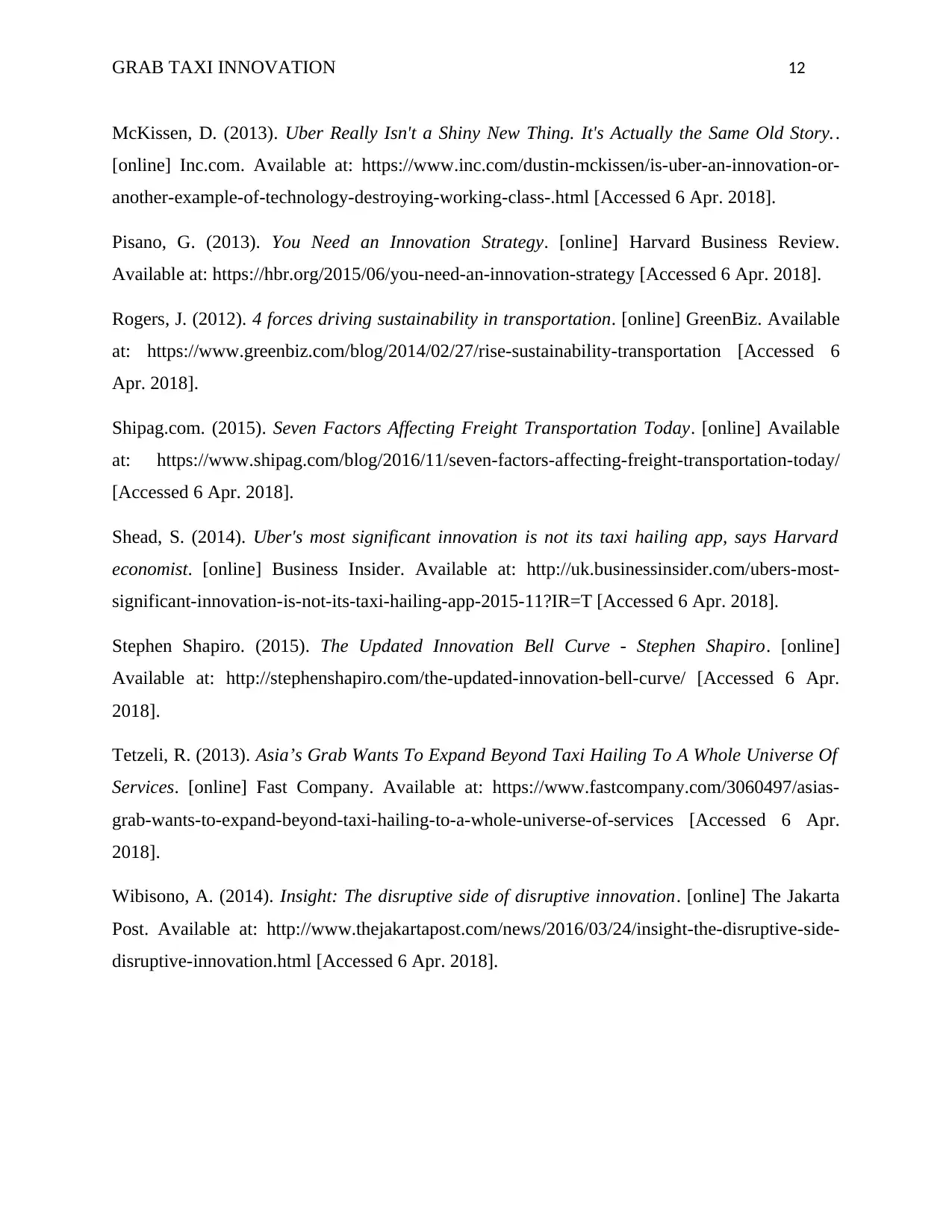
GRAB TAXI INNOVATION 12
McKissen, D. (2013). Uber Really Isn't a Shiny New Thing. It's Actually the Same Old Story..
[online] Inc.com. Available at: https://www.inc.com/dustin-mckissen/is-uber-an-innovation-or-
another-example-of-technology-destroying-working-class-.html [Accessed 6 Apr. 2018].
Pisano, G. (2013). You Need an Innovation Strategy. [online] Harvard Business Review.
Available at: https://hbr.org/2015/06/you-need-an-innovation-strategy [Accessed 6 Apr. 2018].
Rogers, J. (2012). 4 forces driving sustainability in transportation. [online] GreenBiz. Available
at: https://www.greenbiz.com/blog/2014/02/27/rise-sustainability-transportation [Accessed 6
Apr. 2018].
Shipag.com. (2015). Seven Factors Affecting Freight Transportation Today. [online] Available
at: https://www.shipag.com/blog/2016/11/seven-factors-affecting-freight-transportation-today/
[Accessed 6 Apr. 2018].
Shead, S. (2014). Uber's most significant innovation is not its taxi hailing app, says Harvard
economist. [online] Business Insider. Available at: http://uk.businessinsider.com/ubers-most-
significant-innovation-is-not-its-taxi-hailing-app-2015-11?IR=T [Accessed 6 Apr. 2018].
Stephen Shapiro. (2015). The Updated Innovation Bell Curve - Stephen Shapiro. [online]
Available at: http://stephenshapiro.com/the-updated-innovation-bell-curve/ [Accessed 6 Apr.
2018].
Tetzeli, R. (2013). Asia’s Grab Wants To Expand Beyond Taxi Hailing To A Whole Universe Of
Services. [online] Fast Company. Available at: https://www.fastcompany.com/3060497/asias-
grab-wants-to-expand-beyond-taxi-hailing-to-a-whole-universe-of-services [Accessed 6 Apr.
2018].
Wibisono, A. (2014). Insight: The disruptive side of disruptive innovation. [online] The Jakarta
Post. Available at: http://www.thejakartapost.com/news/2016/03/24/insight-the-disruptive-side-
disruptive-innovation.html [Accessed 6 Apr. 2018].
McKissen, D. (2013). Uber Really Isn't a Shiny New Thing. It's Actually the Same Old Story..
[online] Inc.com. Available at: https://www.inc.com/dustin-mckissen/is-uber-an-innovation-or-
another-example-of-technology-destroying-working-class-.html [Accessed 6 Apr. 2018].
Pisano, G. (2013). You Need an Innovation Strategy. [online] Harvard Business Review.
Available at: https://hbr.org/2015/06/you-need-an-innovation-strategy [Accessed 6 Apr. 2018].
Rogers, J. (2012). 4 forces driving sustainability in transportation. [online] GreenBiz. Available
at: https://www.greenbiz.com/blog/2014/02/27/rise-sustainability-transportation [Accessed 6
Apr. 2018].
Shipag.com. (2015). Seven Factors Affecting Freight Transportation Today. [online] Available
at: https://www.shipag.com/blog/2016/11/seven-factors-affecting-freight-transportation-today/
[Accessed 6 Apr. 2018].
Shead, S. (2014). Uber's most significant innovation is not its taxi hailing app, says Harvard
economist. [online] Business Insider. Available at: http://uk.businessinsider.com/ubers-most-
significant-innovation-is-not-its-taxi-hailing-app-2015-11?IR=T [Accessed 6 Apr. 2018].
Stephen Shapiro. (2015). The Updated Innovation Bell Curve - Stephen Shapiro. [online]
Available at: http://stephenshapiro.com/the-updated-innovation-bell-curve/ [Accessed 6 Apr.
2018].
Tetzeli, R. (2013). Asia’s Grab Wants To Expand Beyond Taxi Hailing To A Whole Universe Of
Services. [online] Fast Company. Available at: https://www.fastcompany.com/3060497/asias-
grab-wants-to-expand-beyond-taxi-hailing-to-a-whole-universe-of-services [Accessed 6 Apr.
2018].
Wibisono, A. (2014). Insight: The disruptive side of disruptive innovation. [online] The Jakarta
Post. Available at: http://www.thejakartapost.com/news/2016/03/24/insight-the-disruptive-side-
disruptive-innovation.html [Accessed 6 Apr. 2018].
⊘ This is a preview!⊘
Do you want full access?
Subscribe today to unlock all pages.

Trusted by 1+ million students worldwide
1 out of 13
Related Documents
Your All-in-One AI-Powered Toolkit for Academic Success.
+13062052269
info@desklib.com
Available 24*7 on WhatsApp / Email
![[object Object]](/_next/static/media/star-bottom.7253800d.svg)
Unlock your academic potential
Copyright © 2020–2025 A2Z Services. All Rights Reserved. Developed and managed by ZUCOL.





